When I first started learning about prenatal fitness, I noticed how much confusion there can be around exercise during pregnancy. I wanted to understand what’s safe, what helps with strength and comfort, and how movement can actually prepare the body for labor.
It showed me that prenatal fitness isn’t about pushing hard; it’s about moving in ways that support both health and balance.
Now you can take that same approach. With the right guidance, you’ll know which exercises are safe for each trimester, which ones to avoid, and how nutrition can support your workouts.
This way, you’ll feel confident, comfortable, and ready to stay active throughout your pregnancy.
Disclaimer: Always consult your gynecologist before starting or changing any exercise routine during pregnancy. Every pregnancy is different. Stop immediately if you feel pain, dizziness, or shortness of breath.
Understanding Prenatal Fitness
Prenatal fitness means staying active with exercises that are safe for pregnancy. The purpose is to support your health, ease discomfort, and prepare your body for labor.
Unlike regular exercise, prenatal workouts focus on gentle, low-impact moves that adapt to your changing body. They avoid activities that put stress on their belly, joints, or balance.
Simple movements, such as walking, swimming, and modified strength training, can help keep you strong without risk. The goal isn’t pushing limits but staying mobile, comfortable, and ready for delivery while protecting both you and your baby.
Is Exercise Safe During Pregnancy?

Yes, exercise is generally safe during pregnancy when done with care. Research from groups like ACOG and NIH shows that staying active does not raise the risk of miscarriage, early delivery, or low birth weight.
In fact, it often supports smoother labor and better overall health. A common myth is that movement can harm the baby, but evidence proves the opposite.
Still, precautions matter; speak with your doctor before starting, avoid high-impact activities, and listen to your body. Begin slowly if you’re new to fitness, and focus on safe, steady routines suited to your stage of pregnancy.
Benefits of Prenatal Fitness
Staying active during pregnancy supports your body, mind, and baby, making the experience healthier and more manageable overall.
- Health benefits: Lowers risk of gestational diabetes, preeclampsia, and complications. Builds strength for easier labor and speeds up recovery afterward.
- Emotional benefits: Reduces stress, boosts mood, and improves sleep quality by calming both body and mind.
- Baby benefits: Supports healthy growth, lowers chances of excess birth weight, and improves long-term wellness for your baby.
When to Start Prenatal Workouts
You can usually begin prenatal workouts as early as the first trimester, but it’s important to start gently. If you were already active before pregnancy, you may continue with safer modifications.
Always consult your doctor first, especially if you have health concerns or a high-risk pregnancy. They can confirm what level of activity is safe for you. As for routine, aim for about 20–30 minutes of light to moderate exercise most days.
Maintain a comfortable intensity, stay hydrated, and rest as needed. Consistency matters more than pushing limits, as it helps you build strength safely for the months ahead.
Exercises for First Trimester
Light cardio, gentle stretching, and yoga are ideal. Walking, swimming, or short stationary bike rides keep your heart healthy without strain. Simple stretches reduce stiffness, while yoga builds flexibility and relaxation.
Focus on maintaining energy and building consistency rather than intensity. Always move at a pace that feels right, allowing your body time to adjust to the changes of pregnancy.
1. Easy Walk (15–20 Minutes)
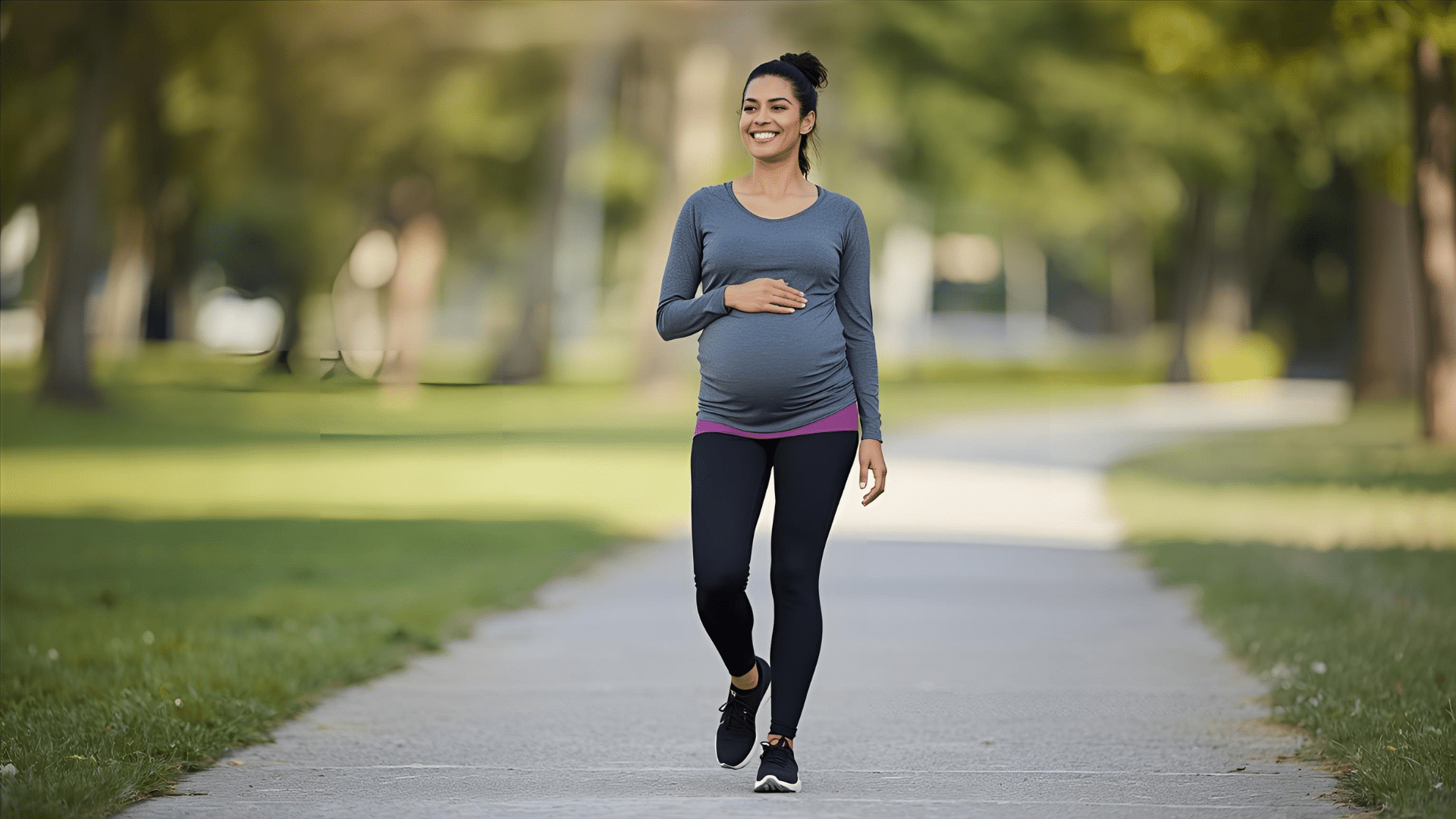
Overview: Take a gentle, low-intensity walk to wake up your muscles and boost circulation without strain.
How to Do It:
- Walk on a flat or gently sloped path for 15–20 minutes.
- Keep a slow, conversational pace where you can speak comfortably.
- Stand tall with shoulders relaxed and arms swinging naturally.
- Focus on even breathing as you go.
Tips to Get More Out of It:
- Focus on steady breathing; you should be able to speak in full sentences without gasping.
- Wear comfortable shoes to reduce foot or knee fatigue.
- Use the last 2–3 minutes to slow down gradually, then stretch your calves and hamstrings.
Why It Works: A light walk at an easy pace improves circulation, warms up your body, and gently raises your heart rate. It’s an ideal warm-up or simple way to add movement to your day.
2. Supported Child’s Pose (30 Seconds)
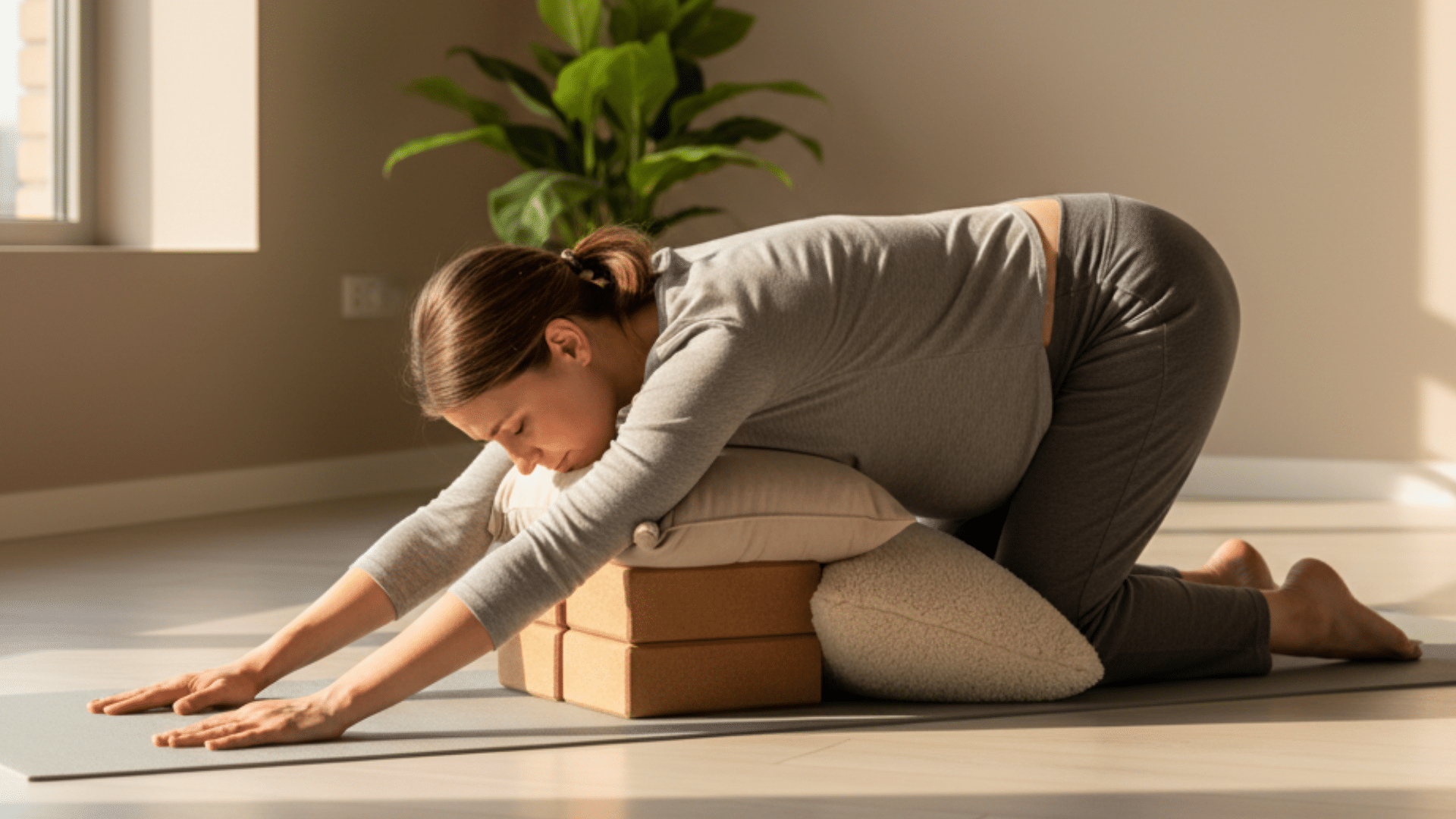
Overview: A restful kneeling pose that opens the hips and calms the nervous system.
How to Do It:
- Kneel with knees apart, wider than your hips, and big toes touching.
- Place a pillow or block under your chest for support.
- Lower your torso onto the pillow, arms forward or alongside your body.
- Rest your forehead on the pillow and breathe slowly for 20–30 seconds.
Tips to Get More Out of It:
- Use extra pillows for comfort under the belly or chest.
- Keep your knees wide enough for your belly to rest easily.
- Focus on slow, steady breathing.
Why It Works: This pose gently stretches the hips and back while promoting relaxation and stress relief.
3. Swimming or Water Walking (15–30 Minutes)

Overview: Water-based exercise reduces joint stress while giving you a light cardio workout.
How to Do It:
- Sit tall on a mat and bring the soles of your feet together.
- Let your knees fall gently outward, keeping your back straight.
- Hold your feet or ankles and breathe deeply for 20–30 seconds.
- Place pillows under your knees if you need extra support.
Tips to Get More Out of It:
- Wear non-slip pool shoes if water walking.
- Stay hydrated even though you’re in water.
- Avoid very hot pools or hot tubs.
Why It Works: Water supports your body weight, easing pressure on joints and reducing swelling while still giving a cardiovascular benefit.
4. Stationary Bike (10–15 Minutes)

Overview: Short, low-resistance cycling indoors keeps your legs active without stressing your joints.
How to Do It:
- Kneel with knees apart, wider than your hips, and big toes touching.
- Place a pillow or block under your chest for support.
- Lower your torso onto the pillow, arms forward or alongside your body.
- Rest your forehead on the pillow and breathe slowly for 20–30 seconds
Tips to Get More Out of It:
- Use a fan or open a window to stay cool.
- Stop if you feel lightheaded.
- Gradually increase time as comfort allows.
Why It Works: A stationary bike offers a safe cardio option without risk of falling and helps keep your leg muscles strong.
Exercises for Second Trimester
This stage is great for safe strength training. Squats and wall pushups help prepare muscles for carrying extra weight and childbirth. Add gentle balance-focused moves to improve stability as your belly grows.
Use light resistance and avoid exercises that strain the abdomen. Keep movements slow and controlled, focusing on posture and breathing.
1. Supported Squats (10–12 Reps)
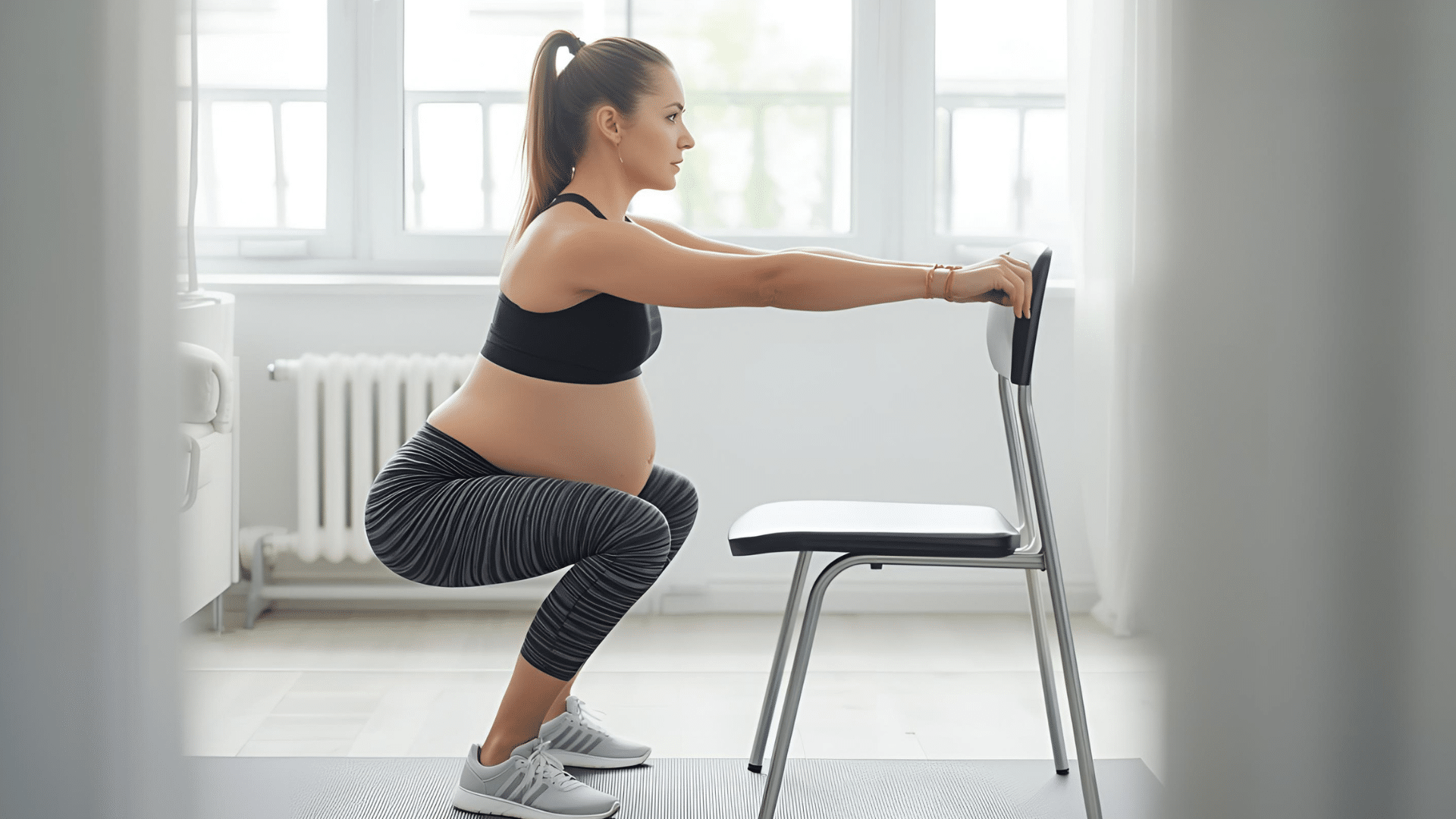
Overview: Strengthen your legs and hips while improving pelvic stability.
How to Do It:
- Stand with feet shoulder-width apart near a sturdy chair or countertop.
- Hold the support lightly with one or both hands.
- Lower yourself slowly into a squat, keeping your back straight and knees over ankles.
- Stop when thighs are parallel to the floor or sooner if needed.
- Push through your heels to stand back up.
Tips to Get More Out of It:
- Hold onto a chair or countertop for balance.
- Keep heels planted and weight evenly distributed.
- Breathe out as you rise back up.
Why It Works: Supported squats build strength for everyday lifting and prepare the body for labor positions.
2. Wall Pushups (8–10 Reps)
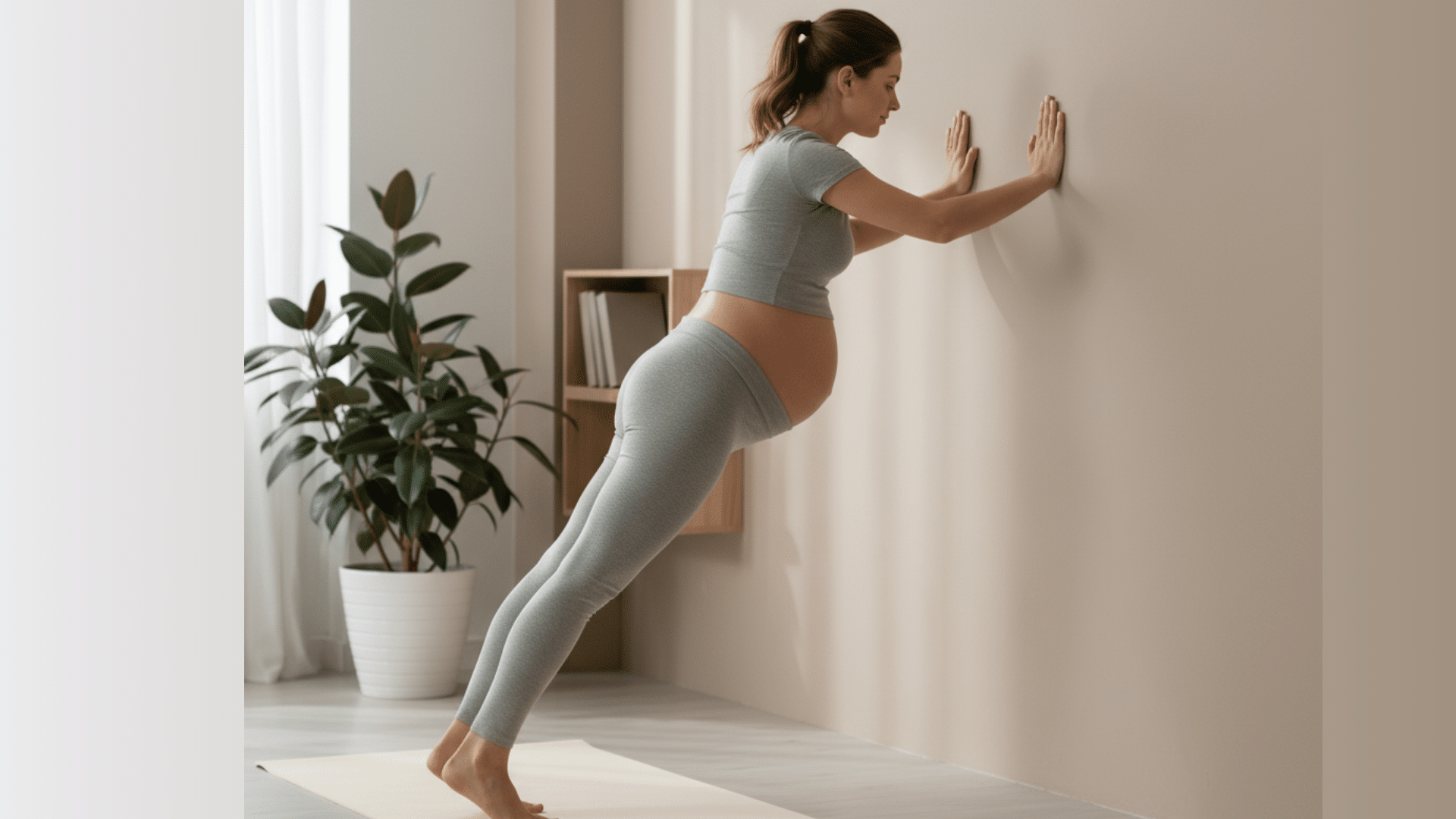
Overview: Build upper-body strength safely without lying flat.
How to Do It:
- Stand facing a wall with feet hip-width apart, arms extended at shoulder height.
- Place your palms flat on the wall, slightly wider than shoulder width.
- Bend your elbows to bring your chest toward the wall.
- Push back out until your arms are straight without locking elbows.
- Keep your body in a straight line from head to heels.
Tips to Get More Out of It:
- Step back farther for more challenge, closer for less.
- Keep your body in a straight line from head to heels.
- Avoid locking elbows at the top.
Why It Works: Wall push-ups strengthen the arms, shoulders, and chest without straining your abdomen.
3. Side-Lying Leg Lifts (10–12 Reps Each Side)

Overview:
Strengthen your hips and outer thighs while staying off your back.
How to Do It:
- Lie on your side with knees slightly bent and head supported.
- Place a pillow under your belly for comfort.
- Lift your top leg slowly to about hip height.
- Lower it gently without letting the knees touch completely.
- Repeat for 10–12 reps, then switch sides.
Tips to Get More Out of It:
- Place a pillow under your belly for support.
- Keep your core engaged but relaxed.
- Don’t raise your leg higher than hip level.
Why It Works: This move improves hip strength and stability, which can help alleviate lower back and pelvic discomfort.
4. Seated Resistance Band Rows (8–10 Reps)
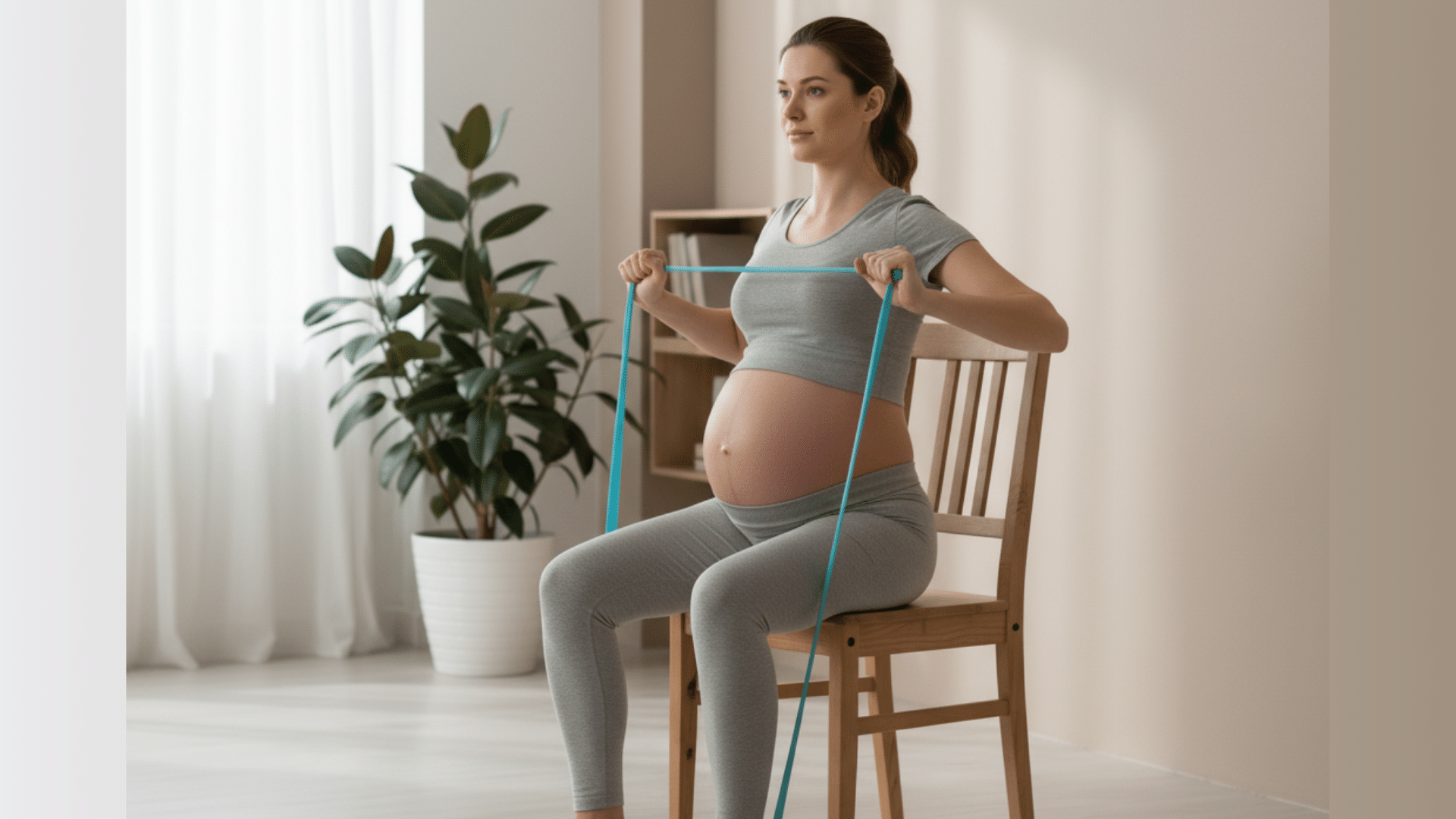
Overview: Strengthen your back and improve posture as your belly grows.
How to Do It:
- Sit upright on a sturdy chair with a resistance band anchored in front of you.
- Hold one end of the band in each hand with arms extended forward.
- Pull the band toward your ribs, keeping elbows close to your sides.
- Slowly release to the starting position with control.
- Keep shoulders down and chest open throughout.
Tips to Get More Out of It:
- Keep shoulders down and chest open.
- Use a light band for minimal resistance.
- Stop if you feel tension in your abdomen.
Why It Works: This exercise supports your spine and shoulders, which helps with posture and reduces back strain.
Exercises for Third Trimester
Low-impact exercises are best now. Walking, seated movements, and gentle stretches keep you active without exhausting your body.
Pair these with breathing and relaxation routines, such as deep breathing or prenatal yoga, to ease tension and prepare for labor. Avoid lying flat on your back for long periods. Prioritize comfort, safety, and flexibility.
1. Seated Marches (30–60 Seconds)

Overview: A gentle seated cardio move to keep blood flowing and legs active.
How to Do It:
- Sit tall on a sturdy chair with feet flat on the ground.
- Lift one knee toward your chest as if marching.
- Lower it and lift the other knee in the same way.
- Continue alternating legs for 30–60 seconds.
- Move your arms lightly if you want more circulation.
Tips to Get More Out of It:
- Keep your core relaxed.
- Move slowly and steadily.
- Add arm swings for extra circulation.
Why It Works: Seated marches improve circulation and reduce swelling in the legs without tiring you out.
2. Cat-Cow Stretch (8–10 Reps)

Overview: A gentle spinal stretch to ease back tension and improve flexibility.
How to Do It:
- Start on hands and knees with wrists under shoulders and knees under hips.
- Inhale as you drop your belly and lift your chest (Cow).
- Exhale as you round your back and tuck your chin (Cat).
- Move slowly between positions for 8–10 reps.
- Use a folded blanket under the knees for cushioning
Tips to Get More Out of It:
- Place a blanket under the knees for cushioning.
- Avoid arching deeply.
- Focus on slow, even breathing.
Why It Works: This stretch relieves lower back pressure, improves spinal mobility, and helps you relax.
3. Deep Breathing with Arm Raises (5–10 Reps)

Overview: Combine breathwork with gentle arm movement to relax and prepare for labor.
How to Do It:
- Sit comfortably with your back supported and feet flat.
- Inhale slowly as you raise your arms overhead.
- Hold the breath for one count.
- Exhale fully as you lower your arms.
- Repeat for 5–10 deep breaths.
Tips to Get More Out of It:
- Close your eyes for more focus.
- Count to four on each inhale and exhale.
- Use this as a daily calming practice.
Why It Works: Breathing exercises lower stress, improve oxygen flow, and teach you relaxation techniques useful during labor.
4. Seated Side Stretch (5–8 Reps Each Side)

Overview: Relieve tension in your sides and ribs as your belly grows.
How to Do It:
- Sit upright on a chair with feet flat.
- Place one hand on your thigh for support.
- Raise the opposite arm overhead.
- Lean gently to the opposite side until you feel a mild stretch.
- Return to center and repeat on the other side for 5–8 reps..
Tips to Get More Out of It:
- Move only as far as feels comfortable.
- Keep hips grounded.
- Breathe deeply into your side ribs.
Why It Works: This stretch opens up your sides, improves ribcage mobility, and eases discomfort from limited space as pregnancy progresses.
Exercises to Avoid During Pregnancy
Not all workouts are safe during pregnancy, so it’s important to know what to avoid to protect yourself and your baby. Here are the exercises you should skip during pregnancy:
- High-impact activities: Running long distances, contact sports, or anything with jumping and risk of falls should be skipped.
- Abdominal crunches, heavy lifting, hot yoga: These can strain your core, raise body temperature, or put pressure on your belly and joints.
- Warning signs to stop: Dizziness, chest pain, bleeding, or shortness of breath are signals to end exercise immediately and consult your doctor.
Creating a Prenatal Workout Plan
Staying active during pregnancy works best when you follow a plan that matches your body’s changing needs. Here’s how you can create a safe and balanced prenatal workout plan that supports you through every trimester:
| Component | Recommendation |
|---|---|
| Cardio | 20–30 minutes of walking, swimming, or stationary cycling most days. |
| Strength | Light weights or bodyweight moves like squats, wall pushups, and modified planks. |
| Flexibility | Gentle stretching or prenatal yoga to improve mobility and reduce stiffness. |
| Relaxation | Deep breathing, meditation, or guided relaxation for stress relief and labor prep. |
| Frequency | Aim for 4–5 days a week, adjusting intensity as pregnancy progresses. |
Prenatal Fitness Classes and Apps
Prenatal fitness options in the US range from local studios to nationwide programs built specifically for moms-to-be.
Studios like the Prenatal Yoga Center in New York City focus on safe yoga routines that strengthen the body and calm the mind. Larger programs such as FIT4MOM offer prenatal group workouts through their FIT4BABY® classes, available in many states, combining exercise with community support.
Online platforms, including LUNA Mother Co., The Bloom Method, and oh baby! Fitness provides structured trimester-based workouts you can follow at home.
Whether you choose in-person guidance or app-based sessions, your decision depends on comfort, convenience, and the level of support you want while staying active during pregnancy.
Nutrition and Prenatal Fitness
Nutrition plays a key role in supporting safe, effective workouts during pregnancy. Eating a small energy-boosting snack, like fruit with yogurt or whole-grain toast with nut butter, helps maintain stamina and prevents dizziness.
Hydration is equally important; drink water before, during, and after exercise to replace fluids and avoid overheating.
Focus on nutrients such as protein for muscle strength, calcium for bones, and iron for healthy blood flow. These choices work together to keep both you and your baby healthy while you stay active.
Prenatal vs. Postpartum Fitness
Exercise before and after pregnancy serves different purposes. Prenatal fitness focuses on supporting your changing body and preparing for labor, while postpartum fitness is about recovery, rebuilding strength, and gently returning to movement.
Here’s how the two compare:
| Aspect | Prenatal Fitness | Postpartum Fitness |
|---|---|---|
| Purpose | Prepares the body for labor, supports comfort, and reduces pregnancy complications. | Helps restore strength, posture, and energy after delivery. |
| When to Start | Safe from the first trimester with the doctor’s approval. | Usually 6 weeks postpartum, but always confirm with your doctor. |
| Workout Type | Light cardio, strength, flexibility, and breathing exercises. | Gentle walks, pelvic floor exercises, and light stretching before progressing gradually. |
Both prenatal and postpartum fitness are important in their own way. By understanding the differences, you can choose the right approach for your stage and give your body the care and support it truly needs.
Conclusion
For me, prenatal fitness is about moving in ways that feel safe and supportive. It’s not about doing more, but about choosing exercises that give strength, ease discomfort, and help prepare the body for recovery after birth. I’ve shared simple ways to get started, what movements to skip, and why small, steady steps matter most.
Now it’s your turn. Think about what feels right for your body and start building a routine you can stick with. Remember, even a little movement each day adds up over time.
If you’d like more wellness ideas, I invite you to check out other blogs on the website for tips, guidance, and encouragement to stay active and confident!





